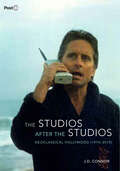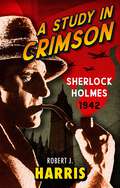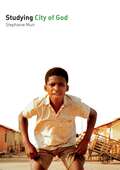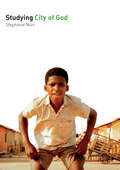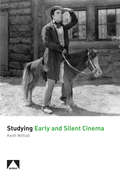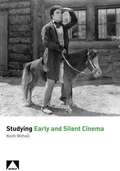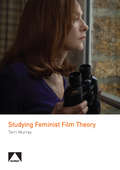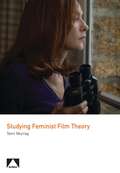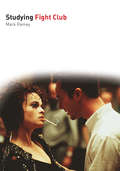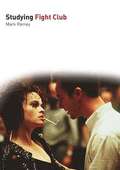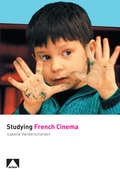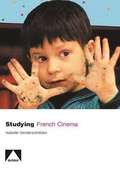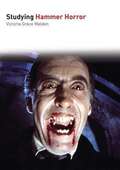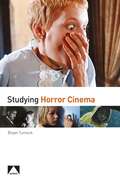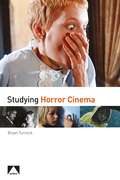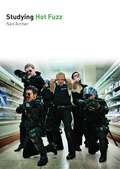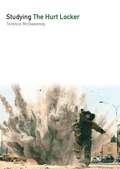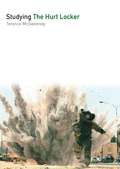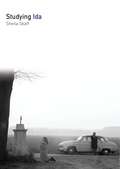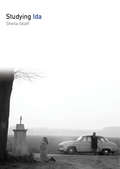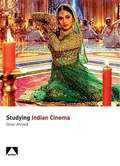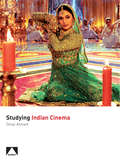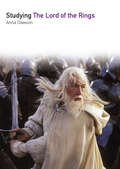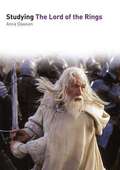- Table View
- List View
The Studios after the Studios: Neoclassical Hollywood (1970-2010) (Post*45)
by J. D. ConnorModern Hollywood is dominated by a handful of studios: Columbia, Disney, Fox, Paramount, Universal, and Warner Bros. Threatened by independents in the 1970s, they returned to power in the 1980s, ruled unquestioned in the 1990s, and in the new millennium are again beseiged. But in the heyday of this new classical era, the major studios movies — their stories and styles — were astonishingly precise biographies of the studios that made them. Movies became product placements for their studios, advertising them to the industry, to their employees, and to the public at large. If we want to know how studios work—how studios think—we need to watch their films closely. How closely? Maniacally so. In a wide range of examples, The Studios after the Studios explores the gaps between story and backstory in order to excavate the hidden history of Hollywood's second great studio era.
A Study in Crimson: Sherlock Holmes: 1942
by Robert J. HarrisA killer going by the name of 'Crimson Jack' is stalking the wartime streets of London, murdering women on the exact dates of the infamous Jack the Ripper killings of 1888. Has the Ripper somehow returned from the grave? Is the selfstyled Crimson Jack a descendant of the original Jack or merely a madman obsessed with those notorious killings?In desperation Scotland Yard turn to Sherlock Holmes, the world’s greatest detective. Surely he is the one man who can sift fact from legend and track down Crimson Jack before he completes his tally of death. As Holmes and the faithful Watson tread the blacked out streets of London, death waits just around the corner.
Studying City of God (Studying Films)
by Stephanie MuirA leading example of a resurgent Latin American cinema – 'la buena onda' – in the early twenty-first century, City of God was a huge international popular and critical success. A combination of intoxicating, Hollywood-style genre film-making and hard-hitting, social-realist subject matter it was hailed as a masterpiece at Cannes in 2002 and seen by over 3 million people in Brazil, including the Brazilian cabinet. In Studying City of God, Stephanie Muir considers: The historical and industrial context of City of God – a brief history of Latin American cinema is followed by a more detailed account of film-making in Brazil – from light-hearted travelogues to Cinema Novo and after – all in the context of increasing globalisation; Narrative and Genre – how the film uses the components of narrative in a complex way, ex-perimentally manipulating time while using traditional genre conventions that are highly recognisable to mainstream audiences; Film language – the formal elements of the film are dissected through a detailed illustrated analysis of the kinetic, scene setting opening sequence; Audience responses – from establishment critical reaction to fan-based Internet sites and student feedback; Representation and Ideology – just how 'authentic' can a film such as City of God hope to be? Does its style overwhelm its subject matter?
Studying City of God (Studying Films)
by Stephanie MuirA leading example of a resurgent Latin American cinema – 'la buena onda' – in the early twenty-first century, City of God was a huge international popular and critical success. A combination of intoxicating, Hollywood-style genre film-making and hard-hitting, social-realist subject matter it was hailed as a masterpiece at Cannes in 2002 and seen by over 3 million people in Brazil, including the Brazilian cabinet. In Studying City of God, Stephanie Muir considers: The historical and industrial context of City of God – a brief history of Latin American cinema is followed by a more detailed account of film-making in Brazil – from light-hearted travelogues to Cinema Novo and after – all in the context of increasing globalisation; Narrative and Genre – how the film uses the components of narrative in a complex way, ex-perimentally manipulating time while using traditional genre conventions that are highly recognisable to mainstream audiences; Film language – the formal elements of the film are dissected through a detailed illustrated analysis of the kinetic, scene setting opening sequence; Audience responses – from establishment critical reaction to fan-based Internet sites and student feedback; Representation and Ideology – just how 'authentic' can a film such as City of God hope to be? Does its style overwhelm its subject matter?
Studying Early and Silent Cinema (Auteur)
by Keith WithallIn this accessible introduction to early and silent cinema, which is currently enjoying a renaissance, both academically and in the popular imagination thanks to The Artist, Keith Withall provides both a comprehensive chronology of the period until the birth of sound and also a series of detailed case studies on the key films from the period – some well known (including Griffith's The Birth of a Nation, Eisenstein's Strike and Chaplin's The Kid), some perhaps less well familiar (including Murnau's The Last Laugh and Oscar Micheaux's Within Our Gates). As well as covering in detail the major film-making figures and nations of the period, the author also provides insights into the industry in less well documented areas. Throughout, the films and film-makers are placed in the context of rapid worldwide industrial change. (Please note this book is a revised and expanded version of Early and Silent Cinema: A Teacher's Guide, published by Auteur in 2007.)
Studying Early and Silent Cinema (Auteur)
by Keith WithallIn this accessible introduction to early and silent cinema, which is currently enjoying a renaissance, both academically and in the popular imagination thanks to The Artist, Keith Withall provides both a comprehensive chronology of the period until the birth of sound and also a series of detailed case studies on the key films from the period – some well known (including Griffith's The Birth of a Nation, Eisenstein's Strike and Chaplin's The Kid), some perhaps less well familiar (including Murnau's The Last Laugh and Oscar Micheaux's Within Our Gates). As well as covering in detail the major film-making figures and nations of the period, the author also provides insights into the industry in less well documented areas. Throughout, the films and film-makers are placed in the context of rapid worldwide industrial change. (Please note this book is a revised and expanded version of Early and Silent Cinema: A Teacher's Guide, published by Auteur in 2007.)
Studying Feminist Film Theory (Auteur)
by Terri MurrayThis book is aimed at helping media and film studies teachers introduce the basics of feminist film theory. No prior knowledge of feminist theory is required, the intended readers being university undergraduate teachers and students of film and media studies. Areas of emphasis include spectatorship, narrative, and ideology. Many illustrative case studies from popular cinema are used to offer students an opportunity to consider the connotations of visual and aural elements of film, narrative conflicts and oppositions, the implications of spectator “positioning” and viewer identification, and an ideological critical approach to film. Explanations of key terminology are included, along with classroom exercises and practice questions. Each chapter begins with key definitions and explanations of the concepts to be studied, including some historical background where relevant. Case studies include film noir, Kathryn Bigelow’s Strange Days and the work of directors Spike Lee, Claire Denis, and Paul Verhoeven.Studying Feminist Film Theory is a revised and expanded version of Feminist Film Studies: A Teacher’s Guide, published by Auteur in 2007.
Studying Feminist Film Theory (Auteur)
by Terri MurrayThis book is aimed at helping media and film studies teachers introduce the basics of feminist film theory. No prior knowledge of feminist theory is required, the intended readers being university undergraduate teachers and students of film and media studies. Areas of emphasis include spectatorship, narrative, and ideology. Many illustrative case studies from popular cinema are used to offer students an opportunity to consider the connotations of visual and aural elements of film, narrative conflicts and oppositions, the implications of spectator “positioning” and viewer identification, and an ideological critical approach to film. Explanations of key terminology are included, along with classroom exercises and practice questions. Each chapter begins with key definitions and explanations of the concepts to be studied, including some historical background where relevant. Case studies include film noir, Kathryn Bigelow’s Strange Days and the work of directors Spike Lee, Claire Denis, and Paul Verhoeven.Studying Feminist Film Theory is a revised and expanded version of Feminist Film Studies: A Teacher’s Guide, published by Auteur in 2007.
Studying Fight Club (Studying Films)
by Mark RameyFight Club is, on one level, pop-culture phenomena and on another, a deeply philosophical and satirical exploration of modern life. David Fincher's 1999 film (and Chuck Palahniuk's source novel) has had a huge impact on audiences worldwide leading to spoofs, homage, merchandising and numerous Internet fan sites. On initial release the film was met with wide hostility from critics who either failed to appreciate its satirical intent or believed the film failed to deliver on its satirical promise. Early in its DVD afterlife, however, a wider audience began to appreciate the film's significance and radical message. Although attracted by the film's playfulness and star wattage, however, many students struggle with its theoretical notions such as Capitalism, materialism, anarchy and so on. This is one film, which therefore merits a thoughtful and provocative analysis but also an accessible one, and Mark Ramey has provided just that.
Studying Fight Club (Studying Films)
by Mark RameyFight Club is, on one level, pop-culture phenomena and on another, a deeply philosophical and satirical exploration of modern life. David Fincher's 1999 film (and Chuck Palahniuk's source novel) has had a huge impact on audiences worldwide leading to spoofs, homage, merchandising and numerous Internet fan sites. On initial release the film was met with wide hostility from critics who either failed to appreciate its satirical intent or believed the film failed to deliver on its satirical promise. Early in its DVD afterlife, however, a wider audience began to appreciate the film's significance and radical message. Although attracted by the film's playfulness and star wattage, however, many students struggle with its theoretical notions such as Capitalism, materialism, anarchy and so on. This is one film, which therefore merits a thoughtful and provocative analysis but also an accessible one, and Mark Ramey has provided just that.
Studying French Cinema (Auteur)
by Isabelle VanderscheldenTaking a text-led approach, with the emphasis on more recent popular films, Studying French Cinema is directed at non-specialists such as students of French, Film Studies, and the general reader with an interest in post-war French cinema. Each of the chapters focuses on one or more key films from the ground-breaking films of the nouvelle vague (Les 400 coups, 1959) to contemporary documentary (Etre et avoir, 2002) and puts them into their relevant contexts. Depending on the individual film, these include explorations of childhood, adolescence and coming of age (Les 400 coups, L'Argent de poche); auteur ideology and individual style (the films of Jean-Luc Godard and Agnes Varda); the representation of recent French history (Lacombe Lucien and Au revoir les enfants); transnational production practices (Le Pacte des loups); and popular cinema, comedy and gender issues (e.g. Le Diner de cons). Each film is embedded in its cultural and political context. Together, the historical discussions provide an overview of post-war French history to the present. Useful suggestions are made as to studies of related films, both those discussed within the book and outside.
Studying French Cinema (Auteur)
by Isabelle VanderscheldenTaking a text-led approach, with the emphasis on more recent popular films, Studying French Cinema is directed at non-specialists such as students of French, Film Studies, and the general reader with an interest in post-war French cinema. Each of the chapters focuses on one or more key films from the ground-breaking films of the nouvelle vague (Les 400 coups, 1959) to contemporary documentary (Etre et avoir, 2002) and puts them into their relevant contexts. Depending on the individual film, these include explorations of childhood, adolescence and coming of age (Les 400 coups, L'Argent de poche); auteur ideology and individual style (the films of Jean-Luc Godard and Agnes Varda); the representation of recent French history (Lacombe Lucien and Au revoir les enfants); transnational production practices (Le Pacte des loups); and popular cinema, comedy and gender issues (e.g. Le Diner de cons). Each film is embedded in its cultural and political context. Together, the historical discussions provide an overview of post-war French history to the present. Useful suggestions are made as to studies of related films, both those discussed within the book and outside.
Studying Hammer Horror (Studying Films)
by Victoria WaldenWhen Hammer Productions was formed in the 1920s, no one foresaw the impact this small, independent studio would have on the international film market. Christopher Lee's mesmerizing, animalistic, yet gentlemanly performance as Dracula, Frankenstein's Monster, and the Mummy were celebrated worldwide, and the Byronic qualities of Peter Cushing's Dr. Frankenstein, among his many other Hammer characters, proved impossible to forget. Hammer maintained consistent period settings, creating a timeless and enchanting aesthetic.Studying Hammer Horror treats Hammer as a quintessentially British product and through a study of its work investigates larger conceptions of national horror cinemas. The book examines genre, auteur theory, stardom, and representation within case studies of Curse of Frankenstein (1957), Twins of Evil (1971), and Hammer's latest film, Beyond the Rave (2008). Walden weighs Hammer's impact on the British film industry, past and present. Intended for students, fans, and general readers, this book transcends superficial preconceptions of Hammer horror in order to reach the essence of Hammer.
Studying Horror Cinema (Auteur)
by Bryan TurnockAimed at teachers and students new to the subject, Studying Horror Cinema is a comprehensive survey of the genre from silent cinema to its twenty-first century resurgence. Structured as a series of thirteen case studies of easily accessible films, it covers the historical, production, and cultural context of each film, together with detailed textual analysis of key sequences. Sitting alongside such acknowledged classics as Psycho and Rosemary’s Baby are analyses of influential non-English language films as Kwaidan, Bay of Blood, and Let the Right One In. The author concludes with a chapter on 2017’s blockbuster It, the most financially successful horror film of all time, making Studying Horror Cinema the most up-to-date overview of the genre available.
Studying Horror Cinema (Auteur)
by Bryan TurnockAimed at teachers and students new to the subject, Studying Horror Cinema is a comprehensive survey of the genre from silent cinema to its twenty-first century resurgence. Structured as a series of thirteen case studies of easily accessible films, it covers the historical, production, and cultural context of each film, together with detailed textual analysis of key sequences. Sitting alongside such acknowledged classics as Psycho and Rosemary’s Baby are analyses of influential non-English language films as Kwaidan, Bay of Blood, and Let the Right One In. The author concludes with a chapter on 2017’s blockbuster It, the most financially successful horror film of all time, making Studying Horror Cinema the most up-to-date overview of the genre available.
Studying Hot Fuzz (Studying Films)
by Neil ArcherBy the power of Greyskull! In their second big-screen collaboration after Shaun of the Dead (2004), with Hot Fuzz (2007) director and co-writer Edgar Wright and co-writer and star Simon Pegg took aim at the conventions of the Hollywood action movie, transplanting gratuitous slo-mo action sequences into the English village supermarket and local pub. In this first critical study of arguably the most influential British film-makers to emerge this century, Neil Archer considers to what extent a modestly funded film such as this can be considered 'British' at all, given its international success and distribution by an American studio, and how far that success depends upon what he calls its 'cultural specificity'. He considers the film as a parody of the action movie genre, and discusses exactly how parody works – not just in relation to the conventions of the action film but also in the depiction of English space. Exactly what and who is Hot Fuzz poking fun at?
Studying Hot Fuzz (Studying Films)
by Neil ArcherBy the power of Greyskull! In their second big-screen collaboration after Shaun of the Dead (2004), with Hot Fuzz (2007) director and co-writer Edgar Wright and co-writer and star Simon Pegg took aim at the conventions of the Hollywood action movie, transplanting gratuitous slo-mo action sequences into the English village supermarket and local pub. In this first critical study of arguably the most influential British film-makers to emerge this century, Neil Archer considers to what extent a modestly funded film such as this can be considered 'British' at all, given its international success and distribution by an American studio, and how far that success depends upon what he calls its 'cultural specificity'. He considers the film as a parody of the action movie genre, and discusses exactly how parody works – not just in relation to the conventions of the action film but also in the depiction of English space. Exactly what and who is Hot Fuzz poking fun at?
Studying The Hurt Locker (Studying Films)
by Terence McSweeneyIn this vibrant and dynamic book-length study drawing on a broad tapestry of research, Terence McSweeney offers an exploration of The Hurt Locker (2009), its stylistic and narrative devices, its cultural impact, its reception, and its relationship to the genre of the war film. McSweeney places the film in a richly textured historical, political, and industrial context, arguing that The Hurt Locker is part of a long tradition of films about American wars that play a considerable role in how audiences come to understand the conflicts that they depict. Thus, films about a nation’s wars are never “only a movie” but rather should be considered a cultural battleground themselves on which a war of representation is waged.
Studying The Hurt Locker (Studying Films)
by Terence McSweeneyIn this vibrant and dynamic book-length study drawing on a broad tapestry of research, Terence McSweeney offers an exploration of The Hurt Locker (2009), its stylistic and narrative devices, its cultural impact, its reception, and its relationship to the genre of the war film. McSweeney places the film in a richly textured historical, political, and industrial context, arguing that The Hurt Locker is part of a long tradition of films about American wars that play a considerable role in how audiences come to understand the conflicts that they depict. Thus, films about a nation’s wars are never “only a movie” but rather should be considered a cultural battleground themselves on which a war of representation is waged.
Studying Ida (Studying Films)
by Sheila SkaffPaweł Pawlikowski’s 2013 film Ida was exceptionally warmly received in the United States, culminating in the Academy Award for Film Not in the English Language, but it was not without controversy. Sheila Skaff’s introduction to the film explains the historical setting, including the violence that took place in the Polish countryside during World War II and was not exposed for sixty years, and provides political and cultural analysis to aid the reader in understanding the film’s setting and narrative. Skaff also touches on the influence of the film on current events in Poland, where censorship of it by an increasingly nationalist government has polarized the country. It also situates Ida within the contexts of Polish and world film history. Scene-by-scene analysis is accompanied in each chapter by background information that gives context to the aesthetic and narrative choices made by the director.
Studying Ida (Studying Films)
by Sheila SkaffPaweł Pawlikowski’s 2013 film Ida was exceptionally warmly received in the United States, culminating in the Academy Award for Film Not in the English Language, but it was not without controversy. Sheila Skaff’s introduction to the film explains the historical setting, including the violence that took place in the Polish countryside during World War II and was not exposed for sixty years, and provides political and cultural analysis to aid the reader in understanding the film’s setting and narrative. Skaff also touches on the influence of the film on current events in Poland, where censorship of it by an increasingly nationalist government has polarized the country. It also situates Ida within the contexts of Polish and world film history. Scene-by-scene analysis is accompanied in each chapter by background information that gives context to the aesthetic and narrative choices made by the director.
Studying Indian Cinema (Auteur)
by Omar AhmedThis book traces the historical evolution of Indian cinema through a number of key decades. The book is made up of 14 chapters with each chapter focusing on one key film, the chosen films analysed in their wider social, political and historical context whilst a concerted engagement with various ideological strands that underpin each film is also evident. In addition to exploring the films in their wider contexts, the author analyses selected sequences through the conceptual framework common to both film and media studies. This includes a consideration of narrative, genre, representation, audience and mise-en-scene. The case studies run chronologically from Awaara (The Vagabond, 1951) to The Elements Trilogy: Water (2005) and include films by such key figures as Satyajit Ray (The Lonely Wife), Ritwick Ghatak (Cloud Capped Star), Yash Chopra (The Wall) and Mira Nair (Salaam Bombay!).
Studying Indian Cinema (Auteur)
by Omar AhmedThis book traces the historical evolution of Indian cinema through a number of key decades. The book is made up of 14 chapters with each chapter focusing on one key film, the chosen films analysed in their wider social, political and historical context whilst a concerted engagement with various ideological strands that underpin each film is also evident. In addition to exploring the films in their wider contexts, the author analyses selected sequences through the conceptual framework common to both film and media studies. This includes a consideration of narrative, genre, representation, audience and mise-en-scene. The case studies run chronologically from Awaara (The Vagabond, 1951) to The Elements Trilogy: Water (2005) and include films by such key figures as Satyajit Ray (The Lonely Wife), Ritwick Ghatak (Cloud Capped Star), Yash Chopra (The Wall) and Mira Nair (Salaam Bombay!).
Studying The Lord of the Rings (Studying Films)
by Anna DawsonUnquestionably the first cinematic phenomenon of the twenty-first century, Peter Jackson's trilogy was a project of enormous artistic vision and financial risk. It is also a rich text for those studying film and media, perhaps for the first time. Studying The Lord of the Rings is the first book to consider the films in these terms, looking in turn at each of the major concepts: their complex origins and narrative structure; issues of representation masculinity, femininity and race; their generic patterns (to which genre do the films belong?) and thematic concerns; their industrial context from theatrical release to DVD extended editions; film language fusing classical mise-en-scène with cutting-edge technological practice. The aim throughout is to highlight critical debates and key terms, to relate these to the texts and to explore their stylistic and cultural impact. This Student Edition (a previously published Instructor's Edition is available) brings the story up to date with reflections on The Hobbit films.
Studying The Lord of the Rings (Studying Films)
by Anna DawsonUnquestionably the first cinematic phenomenon of the twenty-first century, Peter Jackson's trilogy was a project of enormous artistic vision and financial risk. It is also a rich text for those studying film and media, perhaps for the first time. Studying The Lord of the Rings is the first book to consider the films in these terms, looking in turn at each of the major concepts: their complex origins and narrative structure; issues of representation masculinity, femininity and race; their generic patterns (to which genre do the films belong?) and thematic concerns; their industrial context from theatrical release to DVD extended editions; film language fusing classical mise-en-scène with cutting-edge technological practice. The aim throughout is to highlight critical debates and key terms, to relate these to the texts and to explore their stylistic and cultural impact. This Student Edition (a previously published Instructor's Edition is available) brings the story up to date with reflections on The Hobbit films.
